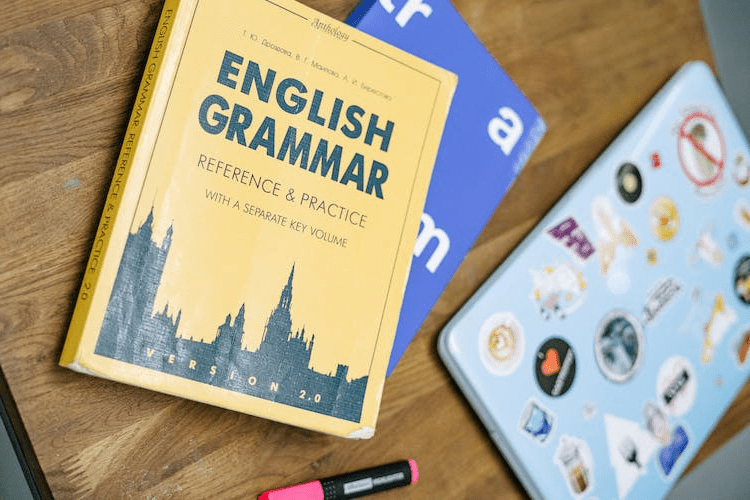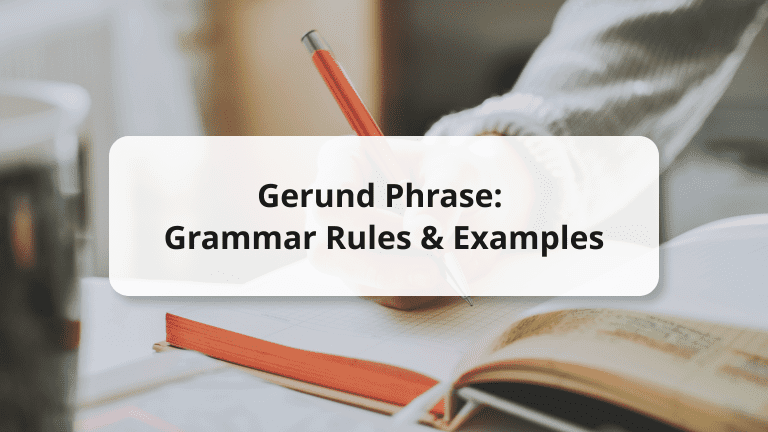A gerund phrase is when a verb takes on an “-ing” and becomes a functional noun. It consists of a modifier and a noun phrase. The function of gerunds is that they can be used alone or together with other words to form a gerund phrase, whereby the gerund phrase behaves like a single noun. Both the gerund and the gerund phrase above function as subject nouns and take the third-person singular verb “is”.
The term gerund has been used in the grammatical description of other languages to label verbal nouns used in a wide range of syntactic contexts and with a full range of clause elements. English grammar rules define gerund; an -ing form used in non-finite clauses such as “playing on computers”. Gerunds are also used in several other languages such as several romance languages (Spanish, Italian, Portuguese), Arabic, Russian, Japanese, and more – with each having the same core principle of a verbal noun.

How do Gerunds Work?
A gerund is a noun that takes the form of a verb that ends with an “–ing”. To understand how gerunds work, let’s first look at how nouns and verbs work. A noun is a word used to refer to places, people, ideas, and things. A verb is a word that refers to the state of being or an action. Therefore, a gerund is a blend of nouns and verbs, and it feels similar to the verb but acts in the form of a noun. Take the gerund “swimming”. You can use the word swimming in the form of a noun in a sentence as an act of moving in the water. For example, you use the word “swimming” as a gerund when you say that ”Swimming is fun”.
When using gerunds in sentences, you treat them as a third-person singular noun. The gerund phrase is a phrase that alters the structure of the sentence to include the gerund, its modifiers, and objects. Since gerunds are derived from verbs, they can take objects, or adverbs and modify them. Similar to noun phrases, gerund phrases are treated in the form of nouns in a sentence. Right now learning gerunds can sound tricky, but once you master it, you’ll learn English faster.
Different Usages of Gerunds
Like nouns and noun phrases, you can use gerund phrases in various sentences. The gerunds can be used as subjects, subject complements, direct objects, objects of prepositions, and predicate nominatives. Here are some different gerund examples to show you how these work. You will be able to see which word in the sentence is a gerund:
1. Gerund as Subject
You would use a gerund as a subject whereby it can represent a noun. This is a way to use a gerund to reference something. Gerunds look like verbs, but it is important to know that these behave like nouns. Therefore, Gerund phrases behave just like noun phrases – meaning that the gerund and the gerund phrase can be the subject of the clauses and sentences or the subject competent connected to the subject by the auxiliary verb. Here are some examples to help understand gerunds as a subject:
Travelling will help you understand the world better.
- Gerund: Travelling
- Direct Object: The World
- Modifier: Better
Hiking is a great way to experience the outdoors.
- Gerund: Hiking
- Direct Object: The Outdoors
- Modifier: Great
2. Gerund as a Direct Object
You would use a gerund as a direct object so it can represent an object of reference. Like nouns and noun phrases, the gerund and the gerund phrases could be used as objects in the clauses and senses. These can be used both as direct objects and objects of prepositions. Here are some examples to help understand gerunds as a direct object:
They enjoy my cooking so much.
- Gerund: Cooking
- Direct Object: Removed, as it is the gerund (cooking)
- Modifier: so much
She loves my singing.
- Gerund: Singing
- Direct Object: Removed, as it is the gerund (Singing)
- Modifier: loves
3. Gerund as a Subject Complement
Because the gerund is a noun, you can use gerunds as a compliment to the subject. Here are some examples to show you how this can be done:
My friend’s favorite hobby is eating all his snacks.
- Gerund: Eating
- Direct Object: snacks (in relation to the gerund used)
- Modifier: favorite
My main priority is sorting my documents.
- Gerund: Sorting
- Direct Object: Documents (in relation to the gerund used)
- Modifier: Main
4. Gerund as an Object of a Preposition
A gerund clause can also be the object of a preposition after a verb, adjective, or noun. When a gerund follows a preposition, it’s an object of the preposition. Here are some examples of how this is done:
The police arrested him for stealing so much jewelry
- Gerund: Stealing
- Direct Object: Jewelry
- Modifier: So much
She stopped herself from eating large slices of cake.
- Gerund: Eating
- Direct Object: Cake
- Modifier: Large
5. Gerund as Predicate Nominative Examples
A gerund can be used as a predicate nominative. This is a noun or pronoun that appears with a linking verb that restates or stands for the subject. Predicate nouns, also known as predicate nominatives, follow the form of the verb “to be” and rename or explain the subject of the sentence.
The most fun activity is playing some games.
- Gerund: Running
- Direct Object: Games
- Modifier: The most fun
The most joy I had in New Zealand was swimming with the Dolphins last month.
- Gerund: Swimming
- Direct Object: Dolphins
- Modifier: The most joy
Gerunds Can Take 2 Different Tenses and 4 Different Forms
A typical grammatical categorization is that gerunds can have four different forms. These four are composed of two present and two perfect tense forms, each in the active and passive voice. Here are some examples to give you an understanding of these tenses and forms:
1. Present Tense Gerund
- Active Voice
In the active voice, the sentence’s subject performs the action on the action’s target. The gerund can either appear in the present tense (whereas it is in the continuous form by its nature).
“We love going for a walk in the rain, and enjoying nature.”
- Passive Voice
In the passive voice, the target of the action is the main focus, and the verb acts upon the subject. An example of a gerund being used in the present tense and passive voice is:
“I don’t like being asked senseless questions.”
This example statement contains a gerund in the passive voice; therefore, it requires the auxiliary verb ‘to be’.
2. Perfect Tense Gerund
- Active Voice
Gerunds can be in “perfect tense” (whereas the auxiliary verb “to have” in the progressive aspect needs to be used for this form). Here is an example:
“Having written all the work emails, he took a break.”
- Passive Voice
Perfect tense gerunds can also be used in the passive voice. Here is an example:
“Having been seen, the burglar ran away.”

Summary of the Different Usages of Gerunds Phrases
Here is a summary of the different usages of a gerund using the same verb (Swimming) to help you better understand the variations:
- Swimming is fun – (gerund as the subject of the sentence)
- I like swimming – (gerund as direct object)
- I never gave swimming all that much effort – (gerund as an indirect object)
- Swimming in the pool is one way to relax – (gerund phrase as subject)
- Do you fancy swimming in the pool? – (gerund phrase as direct object)
- After swimming in the pool, he ate his lunch – (gerund phrase as the complement of a preposition)

Top Tip to Spot Gerunds in Phrases
- Gerunds and gerund phrases are easy to spot in a sentence. Because gerunds are words that are created with verbs but act as nouns, they’re very easy to identify, since every gerund is a verb with an -ing attached to its end, like a suffix.
- The easiest way to spot a gerund is to swap it with a noun and see if the sentence still makes sense. An example sentence to test this would be
“She enjoys her painting.”
The word “painting” is the gerund. If you had to swap “painting” with “artwork” (a noun), the sentence will still make sense:
“She enjoys her artwork.”
Want to deepen your knowledge of gerunds, take some advanced English classes to ensure you are ahead of the curve!
Are You Now Confident in Using Gerund Phrases?
We hope you now have the hang of gerunds and are familiar with their different usage situations. Gerunds are essentially a blend of nouns and verbs that end with “-ing” to make it a continuous verb or to allow it to be used as a subject. Gerunds can be applied in 2 main tenses; present and perfect, with active and passive voices for each. This creates a total of 4 main forms of application of gerunds. The sentence structure of gerund phrases generally has a subject, direct object, and modifier. The examples provided show how to identify these different components of gerund phrases.
As discussed, there are various applications of gerunds such as subjects, subject complements, direct objects, objects of prepositions, and predicate nominatives. The examples shown here are sure to give you the best idea of how to use gerunds appropriately and for the right situations. The summary of gerund applications will definitely help you remember the key differences in each application and variation.

Want to know more interesting English phrases and rules? There are some great beginner English lessons to help you ground your knowledge in the English language with all its rules and structures at AmazingTalker. Take a more casual and practical approach to use English confidently with AmazingTalker, and significantly improve your conversational English.
















